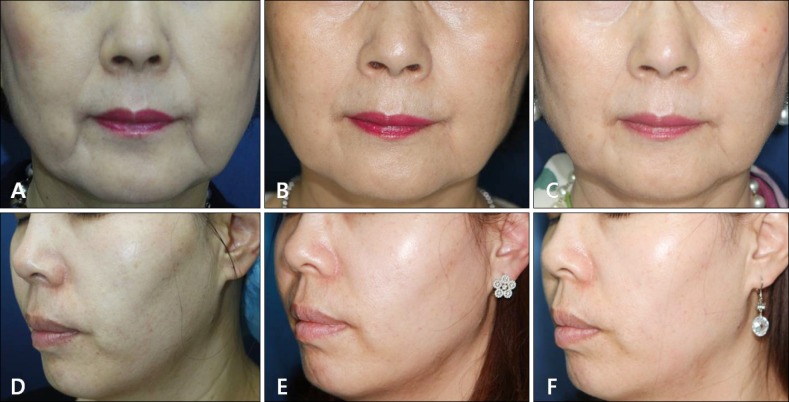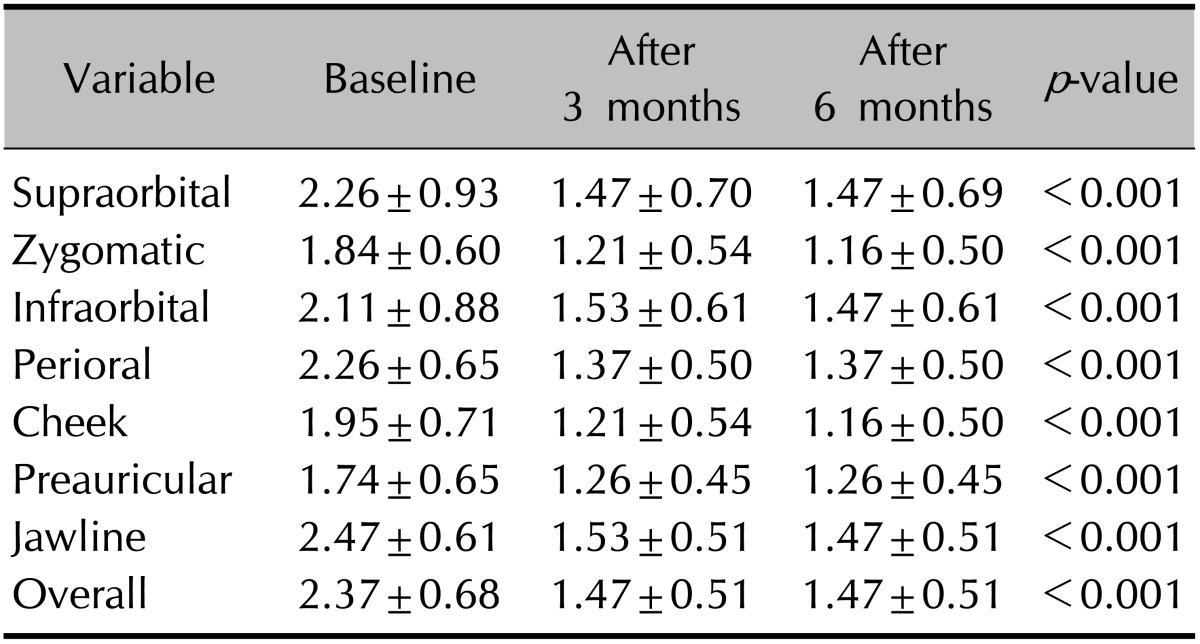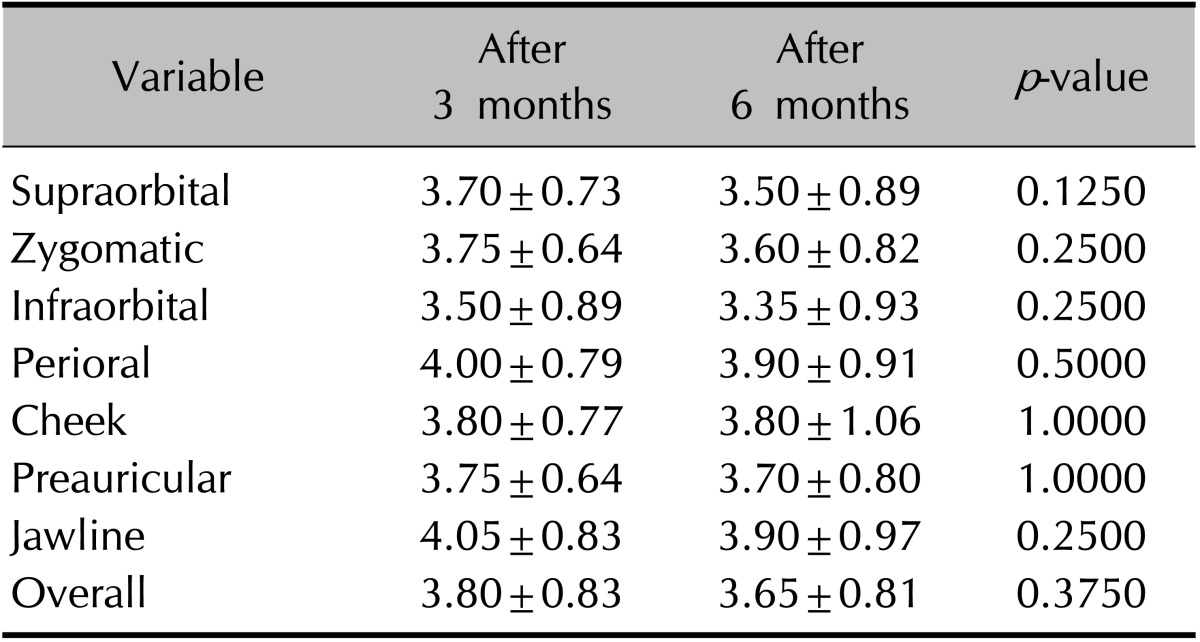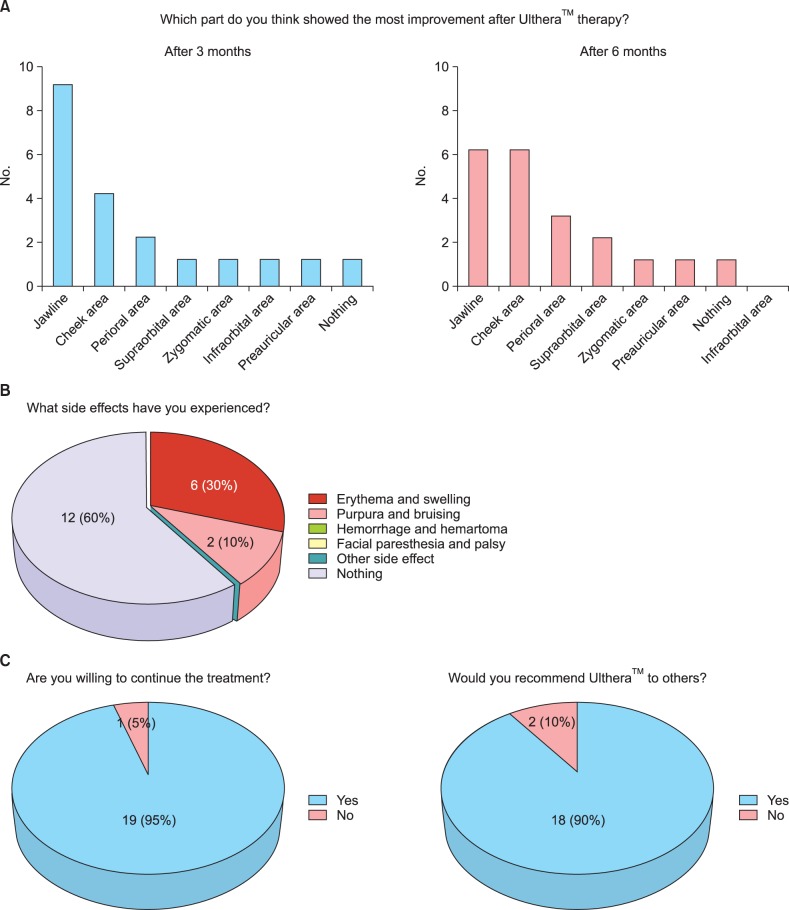Abstract
Background
High-intensity focused ultrasound (HIFU) treatment has recently emerged in response to the increasing demand for noninvasive procedures for skin lifting and tightening.
Objective
This study was aimed at evaluating the clinical efficacy of and patient satisfaction with HIFU treatment for wrinkles and laxity in seven different areas of the face in Asian skin.
Methods
Twenty Korean patients with facial wrinkle and laxity were analyzed after a single session of HIFU treatment. Two independent, blinded clinicians evaluated the clinical improvement in seven areas of the face by comparison of standardized photographs obtained before, and at 3 and 6 months after treatment. Assessment of subjective satisfaction and adverse effects of treatment were done by using questionnaires.
Results
The physicians' evaluation and patients' satisfaction with the clinical effects of HIFU in each area were similar regardless of the number of treatment shots. The jawline, cheek, and perioral areas were the sites where HIFU was most effective, in decreasing order. The adverse effects included erythema and swelling in six cases, and purpura and bruising in two cases. However, the adverse effects were mild and transient.
Conclusion
HIFU could be a safe, effective, and noninvasive procedure that can be used to improve facial wrinkles and skin laxity in Asian skin. It is particularly effective for clinical improvement in the jawline, cheek, and perioral areas.
Keywords: High-intensity focused ultrasound, Laxity, Wrinkle
INTRODUCTION
Recently, there has been increasing public concern about facial wrinkles and loss of elasticity due to aging. In response to this problem, various treatments, including chemical peeling, microdermabrasion, fractional laser, and radiofrequency, have been proposed for the treatment of facial wrinkles and laxity; however, the ideal treatment option has yet to be identified1,2,3,4. Recently, ultrasound was introduced as a new treatment for therapeutic and cosmetic purposes5,6. High-intensity focused ultrasound (HIFU) may be the best example of this technique. White et al.7 reported the first dermatologic, aesthetic use of HIFU in 2008, and HIFU was approved by the Food and Drug Administration in 2009 for use in browlifting. Currently, it is being used for facial rejuvenation, lifting, tightening, and body contouring, which are considered 'off-label' use8,9,10. The principle of HIFU is to induce cellular damage and volume reduction of the target area selectively by means of coagulation by generating instant microthermal lesions through the accumulation of high-frequency ultrasound beams at the specific tissue site without any damage to the epidermis and adjacent issue11.
In this study, we evaluated the clinical improvement, adverse effects, and patient satisfaction through the evaluation of clinical photographs and by using a questionnaire at 3 and 6 months after Ulthera treatment, in patients older than 30 years who desired facial lifting and wrinkle improvement.
MATERIALS AND METHODS
The study protocol conformed to the guidelines of the 1975 Declaration of Helsinki and was approved by the Hanyang Medical Hospital Institutional Review Board and Ethics Committee (IRB No. 2013-01-024).
Twenty patients with facial wrinkles and skin laxity were enrolled in the study. All patients were of Fitzpatrick skin types III and IV. Informed consent was obtained from all patients, consisting of 18 women and 2 men. The patients' ages ranged from 37 to 75 years (mean, 52.3 years). They were treated with a HIFU tightening device (Ulthera system; Ulthera Inc., Mesa, AZ, USA) to the entire face, except for the nose and eyes, by using the following probes: 4 MHz, 4.5-mm focal depth; 7 MHz, 4.5-mm focal depth; and 7 MHz, 3.0-mm focal depth. We used hand pieces that delivered energy at 7.5 MHz and focal depths of 3.0 and 4.5 mm. Topical lidocaine/prilocaine cream (EMLA cream; Astra Pharmaceutical Products Inc., Westborough, MA, USA) was applied under an occlusive dressing for 60 minutes. In three patients, we used a nerve block of the supraorbital, supratrochlear, intraorbital, and mental nerves. After cleaning the face, a layer of ultrasound gel was applied to the skin. Each probe delivered a set of pulses in a linear array at 1-cm intervals. From 400 to 500 shots were delivered according to the size of the face. Standardized photographs of frontal and 45° angle views, along with profiles from each side, were obtained before, and 3 and 6 months after the treatment.
The clinical assessment was based on the evaluation of pretreatment and posttreatment photographs by two independent clinicians who were not directly involved in the treatments. They divided the face into seven areas (supraorbital, zygomatic, infraorbital, perioral, cheek, preauricular, and jawline, excluding the nose and periorbital areas). To assess the severity of facial wrinkles and skin laxity, we modified the eight-point photographic scale suggested by Chung et al.12. Each facial area was evaluated before treatment and after 3 and 6 months by using the following scale: 0, none; 1, mild; 2, mild/moderate; 3, moderate; and 4, severe. The overall clinical improvement was also assessed. In addition, we conducted a survey to assess patient satisfaction and adverse effects. Each patient scored their satisfaction in each area of their faces, and also scored their overall satisfaction with their improvement after treatment on a scale of 1 to 5, as follows: 1, not satisfied; 2, somewhat satisfied; 3, satisfied; 4, very satisfied; 5, extremely satisfied. On the basis of the Global Aesthetic Improvement Scale (GAIS), we subdivided the degree of improvement and satisfaction into five scales in the inverse order of GAIS. We adjusted the order of the scale to make it easier to understand whether the treatment was effective or not. This questionnaire also included several questions about the patients' satisfaction after HIFU treatment, their assessment of adverse effects, and their opinions about whether they would like to undergo further HIFU treatment or whether they would recommend HIFU to others.
All experimental data were analyzed by using paired Student's t-tests with SPSS ver, 12.0 statistical software (SPSS Inc., Chicago, IL, USA). All p-values were two-tailed, and 0.05 was considered statistically significant.
RESULTS
Demographic information
This study included 20 Korean patients (18 women and 2 men), aged 37 to 75 years (mean, 52.3±13.9 years). The number of shots delivered with the HIFU tightening device was 420±59.1.
Physicians' evaluation score
All patients showed clinical improvement after treatment compared with baseline. Representative photos are shown in Fig. 1 (the patients' consent was obtained). All seven areas showed clinical improvement at 3 and 6 months compared with baseline. The improvement was significant at 3 months after treatment, and efficacy was maintained throughout 6 months. The average wrinkle and skin laxity score decreased most in the jawline and periorbital areas (Table 1, Fig. 2).
Fig. 1. Clinical photographs showing before (A, D), 3 months (B, D), and 6 months (C, F) after high-intensity focused ultrasound treatment.
Table 1. Physicians' evaluation score for the treatment areas.
Values are presented as mean±standard deviation.
Fig. 2. Physicians' evaluation score for the treatment areas. 0: none, 1: mild, 2: mild/moderate, 3: moderate, 4: severe.
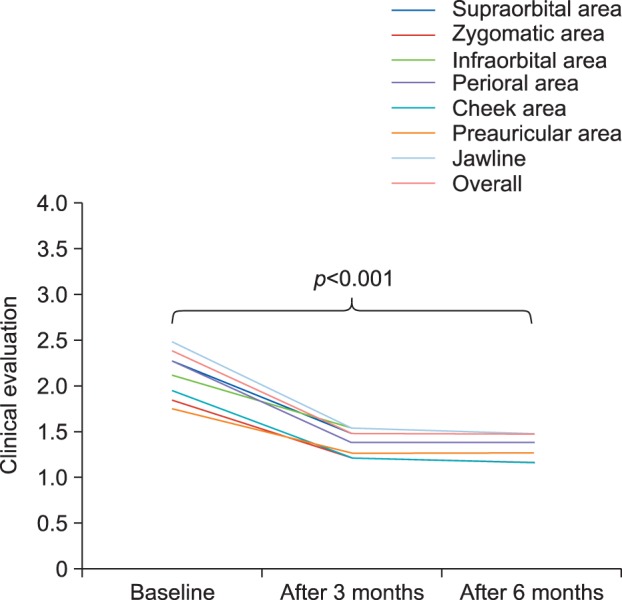
Patients' satisfaction score
On the surveys of patient satisfaction by areas, the scores at 3 and 6 months were 3 or higher. The jawline, perioral, and cheek areas showed the highest satisfaction scores. We observed that after 6 months, satisfaction decreased in all areas, except for the cheek area, which instead showed improvement (Table 2, Fig. 3).
Table 2. Patients' satisfaction score for the treatment areas.
Values are presented as mean±standard deviation.
Fig. 3. Patients' satisfaction score for the treatment areas. 1: not satisfied; 2: somewhat satisfied; 3: satisfied; 4: very satisfied; 5: extremely satisfied.
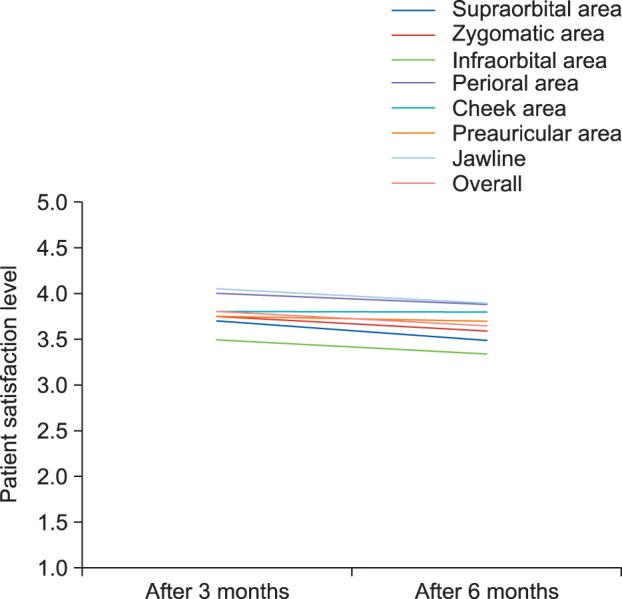
Answers to the question "Which area do you think showed the most improvement after Ulthera treatment?" included the jawline, cheek, and perioral areas at 3 and 6 months after the treatment. However, in a survey after 6 months, satisfaction in the cheek and perioral areas had somewhat increased compared with that in the jawline (Fig. 4A). We also assessed the efficacy and adverse effects 12 months after the treatment by means of a telephone interview or through e-mail. Among 15 patients who replied, 4 patients answered that partial effects were still present in some areas.
Fig. 4. Results of the questionnaire: the most improved area (A), the side effects (B), and the willingness (C) to continue and recommend Ulthera™.
Adverse effects
When we asked about adverse effects, there were six patients with erythema and swelling, and two patients with purpura and bruising. However, these resolved within 2 weeks without any permanent complications (Fig. 4B). No serious adverse events, including neuralgia, nerve palsy, severe edema (lymphatic damage), blistering, or fat atrophy were noted throughout the 6 months after treatment. In addition, no long-term adverse effects were reported in the 15 patients who replied after 12 months.
Willingness to continue and recommend high-intensity focused ultrasound treatment
When we asked if patients wanted to receive more treatments and would recommend the treatment to others, most of them answered positively. However, one patient did not want retreatment because of unsatisfactory effectiveness, and two patients said they would not recommend the treatment to others because of the cost (Fig. 4C).
DISCUSSION
Both intrinsic and extrinsic aging processes contribute to aesthetic changes. Advances in the understanding of skin biology have led to the development of a number of technologies for rejuvenating the skin. Current treatment modalities include ablative and non-ablative lasers, radiofre quency devices, and ultrasound devices1,2,3,4,6,7,8,9,10. Recently, HIFU treatment has received proper medical attention as a 'high-tech' way to improve wrinkles and skin laxity8,9,10. This technique combines direct ultrasound visualization of targeted tissue with the noninvasive delivery of focused ultrasound energy. Precise microcoagulation zones from the deep dermis to the superficial musculoaponeurotic system (SMAS) have been demonstrated. These zones cause gradual tightening of the skin through collagen contraction and remodeling11.
To date, few articles have demonstrated the efficacy of HIFU skin-tightening devices. In 2010, Alam et al.8 reported that HIFU was a safe and effective modality for facial skin tightening. Another recent study showed that HIFU could also be used safely and effectively to improve the skin texture and contour of the upper arms, extensor knees, and medial thighs13. In addition, Suh et al.9 reported clinical and histopathologic changes after HIFU treatment, and suggested that HIFU was a safe, effective, and noninvasive procedure that can be used to tighten the facial skin of Asian people. Unlike in previous studies, we divided the face into seven areas (supraorbital, zygomatic, infraorbital, perioral, cheek, preauricular, and jawline) and then evaluated each part after HIFU treatment.
In this study, regardless of the number of treatment shots, physicians' evaluations and patients' satisfaction with the clinical effects of HIFU seemed similar in all areas. Improvement was prominent after 3 months and showed a gradual decrease with time. The top 3 areas with the highest scores were slightly different in the physicians' evaluations and patients' satisfaction scores, which were the jawline, cheek, and perioral areas in decreasing order for physicians' evaluations, and the jawline, perioral, and cheek areas in decreasing order for patients' satisfaction. Additionally, there was no statistical difference in patient satisfaction at 3 and 6 months (p<0.375). Therefore, subjective satisfaction was sustained for at least 6 months. Also, we observed continuous efficacy in the physicians' evaluation on the zygomatic, infraorbital, cheek, and jawline areas. This might be due to (i) more shots being administered on the zygomatic and cheek areas (200~300 shots) and (ii) the difference in the depth between the dermis and the subcutaneous layer in the infraorbital and jawline areas.
A remarkable finding was that the evaluation by the clinicians and the patients' satisfaction concerning the efficacy of HIFU in each facial area were similar at all time points. However, patients' satisfaction was higher relative to the evaluation by clinicians. This may be because HIFU not only resulted in facial lifting and improvement of wrinkles but also in improvements in skin tone, facial contour, and subjective symptoms such as tightness or tension on the skin.
This study has several limitations. First, only a small number of patients were included in this study because of cost issues. Second, this study did not include controls. However, despite these limitations, the present study demonstrated the clinical and adverse effects of a novel HIFU treatment in a real clinical situation.
In conclusion, we performed facial lifting with Ulthera in 20 patients older than 30 years, and observed clinical improvement and patient satisfaction after the treatment. We consider HIFU to be a safe, effective, and noninvasive option for facial lifting and improvement of wrinkles. Further evidence is needed from studies with more patients conducted at multiple institutions. Additionally, there is a need for studies on patient factors associated with different outcomes, appropriate treatment intervals, number of shots used, equipment settings, and the need for combined therapy with other treatments, such as botulinum toxin. Histologic and molecular approaches are also needed to elucidate the mechanisms underlying changes in the collagen of the dermis to the SMAS layer due to microcoagulation zones.
ACKNOWLEDGMENT
This work was supported by the research fund of Hanyang University (HY-2012).
References
- 1.Lee YB, Eun YS, Lee JH, Cheon MS, Cho BK, Park HJ. Effects of multi-polar radiofrequency and pulsed electromagnetic field treatment in Koreans: case series and survey study. J Dermatolog Treat. 2014;25:310–313. doi: 10.3109/09546634.2012.714454. [DOI] [PubMed] [Google Scholar]
- 2.Shapiro SD, Eros Y, Abrahami Y, Leviav A. Evaluation of safety and efficacy of the TriPollar technology for treatment of wrinkles. Lasers Surg Med. 2012;44:453–458. doi: 10.1002/lsm.22044. [DOI] [PubMed] [Google Scholar]
- 3.Bloom BS, Emer J, Goldberg DJ. Assessment of safety and efficacy of a bipolar fractionated radiofrequency device in the treatment of photodamaged skin. J Cosmet Laser Ther. 2012;14:208–211. doi: 10.3109/14764172.2012.724534. [DOI] [PubMed] [Google Scholar]
- 4.Lee HS, Lee DH, Won CH, Chang HW, Kwon HH, Kim KH, et al. Fractional rejuvenation using a novel bipolar radiofrequency system in Asian skin. Dermatol Surg. 2011;37:1611–1619. doi: 10.1111/j.1524-4725.2011.02134.x. [DOI] [PubMed] [Google Scholar]
- 5.Kleinerman R, Whang TB, Bard RL, Marmur ES. Ultrasound in dermatology: principles and applications. J Am Acad Dermatol. 2012;67:478–487. doi: 10.1016/j.jaad.2011.12.016. [DOI] [PubMed] [Google Scholar]
- 6.Suh DH, Oh YJ, Lee SJ, Rho JH, Song KY, Kim NI, et al. A intense-focused ultrasound tightening for the treatment of infraorbital laxity. J Cosmet Laser Ther. 2012;14:290–295. doi: 10.3109/14764172.2012.738912. [DOI] [PubMed] [Google Scholar]
- 7.White WM, Makin IR, Barthe PG, Slayton MH, Gliklich RE. Selective creation of thermal injury zones in the superficial musculoaponeurotic system using intense ultrasound therapy: a new target for noninvasive facial rejuvenation. Arch Facial Plast Surg. 2007;9:22–29. doi: 10.1001/archfaci.9.1.22. [DOI] [PubMed] [Google Scholar]
- 8.Alam M, White LE, Martin N, Witherspoon J, Yoo S, West DP. Ultrasound tightening of facial and neck skin: a raterblinded prospective cohort study. J Am Acad Dermatol. 2010;62:262–269. doi: 10.1016/j.jaad.2009.06.039. [DOI] [PubMed] [Google Scholar]
- 9.Suh DH, Shin MK, Lee SJ, Rho JH, Lee MH, Kim NI, et al. Intense focused ultrasound tightening in Asian skin: clinical and pathologic results. Dermatol Surg. 2011;37:1595–1602. doi: 10.1111/j.1524-4725.2011.02094.x. [DOI] [PubMed] [Google Scholar]
- 10.Chan NP, Shek SY, Yu CS, Ho SG, Yeung CK, Chan HH. Safety study of transcutaneous focused ultrasound for noninvasive skin tightening in Asians. Lasers Surg Med. 2011;43:366–375. doi: 10.1002/lsm.21070. [DOI] [PubMed] [Google Scholar]
- 11.Brobst RW, Ferguson M, Perkins SW. Ulthera: initial and six month results. Facial Plast Surg Clin North Am. 2012;20:163–176. doi: 10.1016/j.fsc.2012.02.003. [DOI] [PubMed] [Google Scholar]
- 12.Chung JH, Lee SH, Youn CS, Park BJ, Kim KH, Park KC, et al. Cutaneous photodamage in Koreans: influence of sex, sun exposure, smoking, and skin color. Arch Dermatol. 2001;137:1043–1051. [PubMed] [Google Scholar]
- 13.Alster TS, Tanzi EL. Noninvasive lifting of arm, thigh, and knee skin with transcutaneous intense focused ultrasound. Dermatol Surg. 2012;38:754–759. doi: 10.1111/j.1524-4725.2012.02338.x. [DOI] [PubMed] [Google Scholar]



